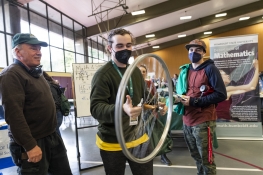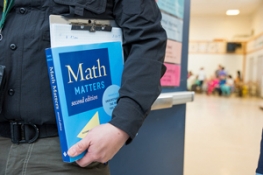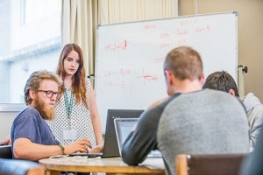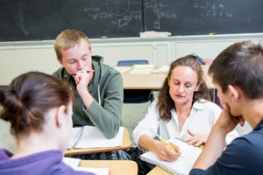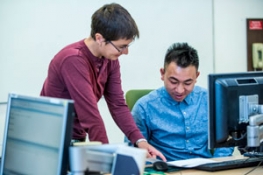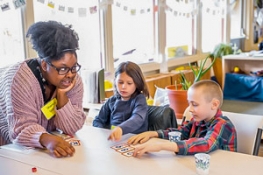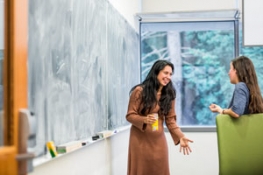Math News
Cal Poly Humboldt Celebrates the Class of 2024!
“I’m so happy for all our graduates and their families and am thrilled they were able to mark this momentous occasion in the manner they deserved—surrounded by those who have supported them throughout this journey,” says Advancement Events & Commencement Coordinator Shannon Collart.
The University adjusted its main Commencement plans, holding multiple ceremonies organized by majors across three local off-campus venues.
The ceremonies took place concurrently in the Eureka Theater, Eureka High School, and the Blue Lake Casino Sapphire Palace. The University also hosted its second annual Regional Commencement ceremony at the Saban Theatre in Beverly Hills. Introduced last year, the regional event is designed to help more families and friends from Southern California celebrate the moment with their graduates.
In total, 1,120 graduates and 258 faculty participated in Commencement and 10,089 guests joined them.
The University modified Commencement due to the campus closure and security concerns. Despite the change of scenery, the ceremonies were just as festive, energizing, and boisterous.
“At each ceremony, you could feel the energy of the crowds. Everyone was cheering—and in some cases very loudly—for their grads,” Collart says. “We know this has been an emotional time, so it was amazing to see how the Lumberjack community came together to make this happen. The families were very appreciative of being able to celebrate this milestone. ”
Shifting to multiple graduation ceremonies in just 10 days underscored the resilience of Humboldt’s community.
Cal Poly Humboldt is deeply grateful to Blue Lake Rancheria, Blue Lake Rancheria Tribal Police Department, Eureka Theater, Eureka High School, Eureka Police Department, Humboldt County Sheriff's Office, Yurok Tribal Police Department, Hoopa Valley Tribal Police Department, Arcata Police Department, and Eureka Community Emergency Response Team.
See Commencement Photos: College of Arts, Humanities & Social Sciences | College of Natural Resources & Sciences | College of Professional Studies | Regional Commencement (Saban Theatre)
More Commencement Information
New graduates are encouraged to register for FREE with Forever Humboldt, the official association for the Cal Poly Humboldt community. Registered members receive ongoing Library access, special discounts at local businesses, access to career resources, special invites to Forever Humboldt events, and more. Get more information on the Forever Humboldt website.
Students are also encouraged to take the Graduation Pledge of Social and Environmental Responsibility, a Commencement tradition that began at Humboldt in 1987 and has been used by more than 100 universities worldwide.
2nd Annual Giving Day: 24 Hours. A Lifetime of Impact.
Cal Poly Humboldt Giving Day is a 24-hour campaign that brings together the campus community to raise funds for students and campus programs. The Cal Poly Humboldt Foundation and members of the Foundation Board and Boldly Rising Campaign Cabinet will match the first $150,000 raised, making your contribution go twice as far and creating a brighter future for Humboldt students. Individual donors will be matched up to $1,000.
Last year, during the University’s inaugural Giving Day, the campus community raised $140,638 in one day. Altogether, 1,003 donors contributed to 112 different campus clubs, programs, departments, and scholarships.
The Giving Day website has 60 featured projects from around campus whose groups will be fundraising on Giving Day, such as the Youth Educational Services (Y.E.S.), Oh SNAP! food pantry, or Toyon Magazine, among other campus programs. Additionally, anyone can visit the fund directory and make a gift to a specific campus department, academic and non-academic program, scholarship, or existing fund they’d like to support.
On Giving Day, everyone is encouraged to donate in any way possible. Any gift, no matter the amount, can significantly impact Humboldt students' lives and learning experiences at Humboldt.
For instance, Anja Wenrick, a parent of a Humboldt alum, recently donated $20 to the Oh Snap! Food Programs fund. Her gift will help students access nutritious and culturally appropriate food and raise awareness of student food insecurity. She says she is glad to be able to help students with this vital campus resource.
James Adams (‘54, Fisheries Biology, ‘58, M.S. Fisheries Biology) gave $25 to the George & Beverly Allen Fisheries Assistantship Fund, which provides experiential learning opportunities to eligible undergraduate or graduate students majoring in Fisheries Biology. Adams says he knew Humboldt Fisheries professor George Allen and his wife Beverly well and wanted to support their legacy and Humboldt Fisheries students.
Giving Day is held on the first Wednesday of April to commemorate Cal Poly Humboldt's first-ever classes, held the first week of April 1914. The University successfully opened with significant financial support from the community. Now, 110 years later, Humboldt continues to offer students a positive, meaningful educational experience with the help of donors at all levels.
Join the Cal Poly Humboldt community in giving to students and programs during the second annual Cal Poly Humboldt Giving Day on April 3. To make a contribution or for more information, visit giving.humboldt.edu/giving-day.
Questions? Contact the Cal Poly Humboldt Foundation at giving@humboldt.edu or (707) 826-5200
80th Kieval Lecture Continues Celebration of Mathematics
The guest lecture is free and open to the public.
Goins’ presentation shows that the three points (0,0), (3,0), and (3,4) form a 3-4-5 triangle. In particular, the distance between each pair of points is an integer. In 1945, Paul Erdos and Norman Anning showed that for any integer of at least 3, there is a collection of n points in the plane, not all on a line, such that their pairwise distances are integers.
In 2000, Nate Dean asked: “Are there four points on a parabola such that each pairwise distance is a rational number?” Garikai Campbell answered this question in 2003 using elliptic curves.
But what about shapes other than lines or parabolas? Richard Guy, in his book Unsolved Problems in Number Theory, asked: "What is the largest number of points in the plane such that (1) all pairwise distances are rational numbers, (2) no three of the points are on a line, and (3) no four of the points are on a circle?"
Goins will discuss the results discovered by his students who worked on this problem in 2010. His talk will also feature the personal relationships he gained working with African American mathematicians to find points on conic sections at rational distances.
Goins' lecture is dedicated to the life, works, and friendship of the late African American mathematician Nate Dean, who passed away in 2021.
Goins will also give a separate lecture earlier the same day as a part of the Cal Poly Humboldt Mathematics Colloquium. That lecture titled, “Clocks, Parking Garages, and the Solvability of the Quintic: A Friendly Introduction to Monodromy,” will begin at 4 p.m. in Room 166 of the Behavioral and Social Sciences (BSS) building. The colloquium talk is also free to the public. Learn more about the Mathematics Colloquium.
Goins grew up and attended school in south Los Angeles. He attended the California Institute of Technology, where he majored in Mathematics and Physics, and earned his doctorate in Mathematics from Stanford University. He has worked as a researcher at both Harvard and the National Security Agency; and has taught at both Caltech and Purdue University.
He has published more than 25 journal articles in areas such as applied mathematics, graph theory, number theory, and representation theory; and on topics such as Diophantine equations, elliptic curves, and African Americans in mathematics. He runs a federally-funded Research Experience for Undergraduates program titled Pomona Research in Mathematics Experience.
Learn more about about Goins's work and accomplishments.
The Kieval lecture series is named for Mathematics Professor Emeritus, Harry S. Kieval, who taught at Cal Poly Humboldt from 1966 to 1979. The series includes topics on popular and/or broad aspects of mathematics attractive to undergraduates and the public. Learn more about the Kieval Lecture.
HSU Students Use Math to Solve Real-World Problems in International Competition
HSU’s two teams—Jacob Turner, Josh Steiner, Tyler Caseltine; and Terran Hilden, Tran Huyen (Sky) N. Pham, and Cavanaugh Carter—were among 26,000 teams from universities around the world from 18 different countries that participated in the contest, sponsored by the Consortium for Mathematics and Its Applications (COMAP).
Putting their math and communication skills to the test, students spent four days in January tackling one of six real-world problems and summarizing their solution in a written report. The results were announced last week.
Turner, Steiner, and Caseltine’s problem required them to build an emergency evacuation model for the Louvre Museum. They explored ways to evacuate visitors with minimal interference to emergency personnel entering the building. They competed against 5,728 teams and were awarded a ranking of Meritorious Winners. Only 15 teams received a higher score.
Hilden, Pham, and Carter made a strong showing, too. Selecting a problem focused on the current opioid epidemic in the U.S., they needed to construct a model based on data provided by the Drug Enforcement Agency to determine the severity of the epidemic without intervention. A total of 5,125 teams selected to work on this question, and Terran, Sky, and Cavanaugh were awarded the score of Successful Participant.
“This is an extremely competitive event,” says Elizabeth A. Eschenbach, department chair and professor of Environmental Resources Engineering. “Their achievement continues the tradition of excellence of previous teams and brings recognition to the Environmental Resources Engineering Department, the College of Natural Resources and to Humboldt State University.”
The Math and History Behind House Representation
In his new book, “The History of Congressional Apportionment”, published by the Humboldt State University Press, Biles explores the history, heated political fights, the people, and the math of congressional apportionments.
The book sheds light on the census and how people are “counted.” For example, slaves were not counted as a whole person, which affected the overall population count, representation, and the disenfranchisement of an entire population.
Biles uses his mathematical knowledge and insight to tell a flowing, evolutionary story—an interdisciplinary approach that stems from his research in mathematical modeling and the modeling of natural resource systems.
Through the lens of Congressional apportionment, this book adds another chapter to the rich story of American history and the people, politics, and debates that continuously shape the political system we have today.
On Tuesday, Nov. 7, from 4-5 p.m., Biles will be giving a talk on “The Electoral College vs. The Popular Vote” at the HSU Library Scholars Lab. Voter registration materials will be available for those who want to take home a form or sign up on the spot.
About Humboldt State University Press
Humboldt State University Press publishes high-quality scholarly, intellectual, and creative works by or in support of the HSU campus community. HSU Press operations and publications support the HSU mission to improve the human condition and our environment by promoting understanding of social, economic, and environmental issues. All electronic publications are openly available on the Digital Commons platform, a network that brings together free, electronic scholarly texts from hundreds of universities and colleges around the world.
For questions or more information about Humboldt State University Press, please contact HSU Scholarly Communications and Digital Scholarship Librarian, Kyle Morgan at kyle.morgan@humboldt.edu or (707) 826-5602.
Acclaimed Mathematician to Speak at HSU
The title of the lecture is “Gems of Ramanujan and their Lasting Impact on Mathematics.”
Ono will discuss the work of Indian mathematician Srinivasa Ramanujan (1887-1920) and its profound effect on modern mathematics and Ono’s research. Among his many accomplishments, Ono is an associate producer of a film about Ramanujan, “The Man Who Knew Infinity” (starring Dev Patel and Jeremy Irons). He will share several clips from the film during his talk. No previous knowledge of the subject will be assumed, and the lecture will be accessible to a general audience.
This is the 70th Harry S. Kieval Lecture. The lecture series is named for HSU Mathematics Professor Emeritus, Dr. Harry S. Kieval, who taught at HSU from 1966 to 1979. The series includes topics on popular and/or broad aspects of mathematics attractive to undergraduates and the public.
The lecture takes place in Founders Hall Room 118 on the HSU campus, starting at 7:30 p.m. Tuesday, September 12, 2017. This event is free to the public.
Visit this link for more information.
Students Grab Top Prize In Global Interdisciplinary Modeling Contest
For the last 16 years, student teams from HSU’s Department of Environmental Resources Engineering and Department of Mathematics have participated in the four-day math modeling competition. This year HSU had 10 teams competing in the contest, which consists of two parts: the Mathematical Modeling Contest and the Interdisciplinary Contest in Modeling, both sponsored by the Consortium for Mathematics and its Applications (COMAP). During the online contest, teams of three students researched, modeled, and communicated a solution to either a mathematics or interdisciplinary modeling problem.
Environmental Resources Engineering students Yaad Rana, Marcela Jimenez, and Joshua Martinez received the highest ranking possible, Outstanding Winner, for their submission. The team was one of only 14 out of 8,085 competitors to achieve the ranking, and one of only two teams to win the Two Sigma Scholarship Award, which provides a stipend of $3,000 for each of the team members and a $1,000 award to the Department of Environmental Resources Engineering.
The team also received the Rachel Carson Award, which honors the American conservationist whose book “Silent Spring” initiated the global environmental movement. This award is presented to a team for excellence in using scientific theory and data in its modeling.
In the competition, teams select from series of problems to work on. Rana, Jimenez, and Martinez focused on urban planning by looking at smart growth and sustainable cities. The teams sought to understand and model the principles of modern urban planning to improve city operation. The problem challenged the students to utilize a diverse set of skills including science, mathematics, politics, government operations, data science, and analysis in their modeling. The team searched for pertinent data and grappled with how internal and external issues needed to be considered, all while competing against teams from Australia, Canada, China, Hong Kong SAR, Indonesia, Singapore, the United Kingdom, and the United States.
A selection of Rana, Jimenez, and Martinez’s solution paper will be featured in the “Journal of Undergraduate Mathematics and Its Application.”
The 14 Outstanding Winners represented the following schools:
- Anhui University, China
- Brown University, R.I.
- Harvard University, Mass.
- Harvey Mudd College, Calif.
- Humboldt State University
- Nanjing University Of Aeronautics And Astronautics, China
- NC School of Science and Mathematics, N.C.
- Shanghai Jiao Tong University, China
- United States Military Academy, N.Y.
- University of Electronic Science and Technology of China
- Zhejiang University
Mathematics Expert Analyzes Voting, Preferences in 69th Kieval Lecture
“Mathematics actually has something interesting to say about social sciences, and social sciences can motivate new mathematical questions,” Su said during an address to the MAA last year.
Currently the Benediktsson-Karwa Professor of Mathematics at Harvey Mudd College, Su is a Harvard-educated math expert renowned for his teaching and ability to make complicated mathematical concepts accessible to the public.
Su’s lecture, “Voting in Agreeable Societies,” will analyze a form of voting known as approval voting. Approval voting is a single-winner voting method, where each voter may “approve” any number of candidates. The winner is the most approved candidate. Most elections use plurality voting to determine the winner, but Su suggests approval voting could let voters make broader selections. “The idea is you can vote for as many candidates as you want, and the person with the most votes wins. If you have eight people in an election, you vote for 4 you like,” says Su.
Su’s talk will demonstrate how the geometry of data sets and their intersections can be used to model people’s preferences and understand approval voting operates in “agreeable” societies, where among every three individuals, a pair can agree on one candidate.
He will discuss questions such as: When does a majority exist? How does the geometry of the political spectrum influence the outcome? What does mathematics have to say about how people behave? The talk will be accessible to a general audience and assume no previous knowledge of the subject.
This is the 69th Harry S. Kieval Lecture. The lecture series is named after HSU Mathematics Emeritus Professor Harry S. Kieval, who taught at HSU from 1966 to 1979. Professor Kieval funded the lecture series to bring prominent mathematicians to the HSU campus two times per year to discuss popular and/or broad aspects of mathematics attractive to undergraduates and the public.
The lecture takes place in the Science B building, Room 135, on the HSU campus, starting at 7:30 p.m. Thursday, February 2, 2017. This event is free to the public.
When: Thursday, February 2, 2017, 7:30 p.m.
Where: Science B, Room 135, Humboldt State University, 1 Harpst Street, Arcata
Cost: Free
Website: http://www2.humboldt.edu/math/news-and-events/kieval-lecture
Contact: 707-826-3143
Mirror Image Symmetry from Different Viewpoints
The Pomona College mathematics professor will explain why it is important to determine whether a molecule has mirror image symmetry, and discuss the differences between a geometric, chemical, and topological approach to understanding mirror image symmetry. Finally, she will present some of her results on topologically asymmetric molecules.
Flapan currently holds the Librun H. Burkhead professorship in the Department of Mathematics at Pomona College. After postdoctoral studies at Rice University and UC Santa Barbara she joined the Pomona faculty in 1986. Her research is in low-dimensional topology and knot theory.
Recognized for her ability to connect with students, she won the Mathematical Association of America’s Haimo Award for Distinguished Teaching in 2011. Flapan has also published numerous articles and four books, including 2015’s “Knots, Molecules, and the Universe: An Introduction to Topology.”
The Humboldt State University Department of Mathematics Harry S. Kieval Lecture is named for HSU Mathematics Professor Emeritus Dr. Harry S. Kieval, who taught at HSU from 1966 to 1979. The series includes topics on popular and/or broad aspects of mathematics attractive to undergraduates and the public.
##
When: Thursday, Dec. 1, 2016, 7:30 p.m.
Where: Founders Hall Room 118, Humboldt State University
Download an HSU campus map PDF
Cost: Free
Website: http://www2.humboldt.edu/math/news-and-events/kieval-lecture
/>
Contact: HSU Dept. of Mathematics 707-826-3143

